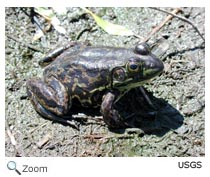Mink Frog - Lithobates septentrionalis |
|||||||||
Description Range |
HabitatThe mink frog is found at the edges of ponds, bogs, and lakes with cool water and emergent vegetation or peaty bottoms. It spends most of its time in the water and is especially fond of lily pads. Diet
The mink frog eats aquatic insects, snails, spiders, and other invertebrates. The mink frog tadpole eats algae and plant matter. Life CycleBreeding season runs from May through August. Males float in the water and call to the females. The female lays a mass of 500-4,000 eggs in deep water. The male fertilizes the eggs after the female lays them. The tadpoles become frogs in about a year. BehaviorThe mink frog gets its name from the musky mink-like odor it produces when it is picked up or disturbed by a predator. Some people compare the smell to rotting onions. |
||||||||
| Audio Credit: USGS Upper Midwest Environmental Sciences Center | |||||||||


 The mink frog
is found in northern New England and New York and in Northern Minnesota, Michigan, and Wisconsin. It is also found in Canada from Nova Scotia west to Manitoba. The mink frog is found in northern New Hampshire.
The mink frog
is found in northern New England and New York and in Northern Minnesota, Michigan, and Wisconsin. It is also found in Canada from Nova Scotia west to Manitoba. The mink frog is found in northern New Hampshire.